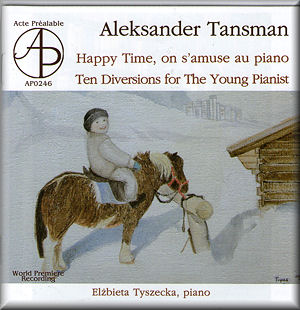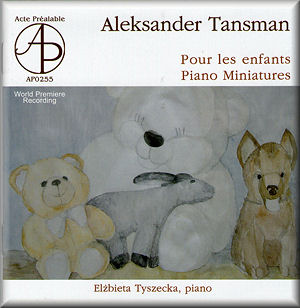 |
 |
| 
Buy
through MusicWeb
for £13.50 postage paid World-wide.
Musicweb
Purchase button |
Aleksander TANSMAN
(1897-1986)
Happy Time, on s’amuse au piano [44:13]*
Book I (Primary) [11:36]; Book II (Elementary) [16:29]; Book III
(Intermediate) [16:08]
Ten Diversions for the Young Pianist [14:04]*
 Elzbieta Tyszecka (piano)
Elzbieta Tyszecka (piano)
rec. Kameralna Hall named after Henryk Czyza, Lódz Philarmonia,
Lódz, Poland, March and July 2011. *World premičre recordings.
 ACTE PREALABLE AP0246 [58:42]
ACTE PREALABLE AP0246 [58:42] |
| 
Buy
through MusicWeb
for £13.50 postage paid World-wide.
Musicweb
Purchase button |
Aleksander TANSMAN (1897-1986)
Pour les enfants pour piano de difficulté progressive [54:11]*
1er Recueil, trčs facile [11:16]; 2e Recueil, facile [12:13]; 3e
Recueil, assez facile [12:47]; 4e Recueil, moyenne difficulté [17:55]
Piano miniatures (1945)[6:56]*
 Elzbieta Tyszecka (piano)
Elzbieta Tyszecka (piano)
rec. Kameralna Hall named after Henryk Czyza, Lódz Philarmonia,
Lódz, Poland, July and October 2011. *World premičre recordings.
 ACTE PREALABLE AP0255 [61:32]
ACTE PREALABLE AP0255 [61:32]
|
| |
I always get a frisson of excitement at the prospect of hearing
world premičre recordings. Accordingly, I looked forward with
relish to reviewing these discs of music by Tansman for children
to play.
Lódz-born composer Aleksander Tansman spent most of his life
in France where he immigrated in 1919 after the young composer
discovered that his works did not appeal to the critics of the
day. I sometimes wonder why it is that certain countries appear
to undervalue their own composers while others embrace them.
In the case of these piano works it seems that pianists in Poland
also ignored them until relatively recently which is a great
shame as they are so appealing. Tansman wrote them as he explained
“... to bridge the abysmal gap, for the very young pianist,
between the school’s methodical exercises and the real repertoire
of the great masters” and to “construct a bridge between scales
and exercises on the one hand and the whole repertory from Bach
and Handel until the present times on the other”. While it is
true that they are more interesting the more difficult they
become it is equally true that all are charming and intelligently
written little gems in their own right. They work well, as proved
here, away from the young pianists’ practise rooms and in the
concert hall and recording studio. Indeed they have also been
transcribed for the likes of harp and harpsichord as well as
being played in their original form. Tansman clearly took his
aim to provide young pianists with interesting and valuable
pieces to play extremely seriously. He even made sure that the
art of the accompanist and budding chamber musician was covered
by writing simple works for various combinations including violin
and piano, cello and piano and violin, cello and piano as well
as for piano four hands and for two violins.
These pieces were written in 1960 and are delightful miniatures
covering a whole range of styles and moods as well as being
influenced by various “exotic” locations such as in Arabia,
Versailles, Swedish Dance, Oriental Dance,
Iberian Mood and even a slice of Americana in the shape
of In Memory of George Gershwin. Ten Diversions
for the Young Pianist, written in Beverly Hills, USA in
1946 presents the young pianist with differing moods to capture,
from calmness to sadness and from concentrating at prayer to
mischievous behaviour and much else besides. Writing successful
piano miniatures always reminds me of writing successful short
stories in that to make them work and to represent what the
composer was aiming at requires even greater skill than it does
when more time is available. I was reminded of this particularly
in track 40 Dreams where the illusion of dreaming is
precisely described in one minute and thirteen seconds which
is quite amazing. It is true that a number of composers wrote
music for children to play and I recently reviewed a brilliant
disc of such music by Mieczyslaw Weinberg (CPO 777 517-2). In
Weinberg’s case they were written in 1944 for his 12 year old
daughter to play whilst the photos in the Tansman discs booklets
are presumably of his daughters. They look to be quite a bit
younger than that which may help explain the comparative simplicity
of these pieces. The photos appear in the booklets of both discs
but are more likely to pertain to the second disc since these
works were written in 1933 as a commission from a publishing
house. Maybe he used his daughters as ‘practise material’ to
see whether they could manage to play them or maybe they are
there just to represent childhood, though surely they must have
played having such a father. This second disc is of two works,
the first a group of piano pieces for children described in
French as being “of progressive difficulty” and which comprises
four collections subtitled “very easy, easy, fairly easy, average
difficulty”.
Tansman had an incredible facility for writing simple though
interesting pieces that children would find it possible to play
but that do not reveal their best until and unless the pianist
is able to master the piece completely before moving on to the
next level. These are to be practised to make perfect because,
though I am no pianist, I can well imagine that trying to play
Russian Dance (track 6) which only lasts a mere 44
seconds in a convincing way must require a skill somewhat greater
than that intimated in the description “very easy”. When moving
on to “easy” the young pianist is presented with Mazurka
in which they have a tiny 28 seconds in which to demonstrate
this vigorous Polish dance. La Toupie is 29 seconds
of fiendishly fast playing. I can imagine the youngster’s relief
when the next few items are slow and relaxed by comparison.
As I said at the beginning the marvellous thing about these
pieces are that they stand on their own as being fascinating
little marvels in their own right; they may be for children
but they are emphatically not childish.
The booklet notes, written by the pianist here Elzbieta Tyszecka,
suggest that the first set was written for children of pre-school
age to which one can only think that anyone who could truly
get on top of these pieces at such an early age should go on
with their studies and consider taking up a career as a pianist.
I don’t wish to suggest that they or any of the others are too
taxing. However they allow enough scope to stretch the young
person to achieve a high level of ability and if they end up
being able to play them like this pianist does they will have
done so. The collection certainly expands the child’s view of
the world with excursions to far flung places from Russia in
the Russian Dance (track 6), to America in Le petit
nčgre (track 20). Then there’s Jeux Balinais
(track 44) with it representation of the Javanese gamelan. The
five Piano Miniatures, which were written in 1945,
while perhaps for the older piano student still retain that
element of learning the craft that means that while they may
be achievable they still require that extra effort to make them
perfect.
These discs are very enjoyable to listen to and are varied enough
never to be boring. Each piece has something to say in an incredibly
short time and says it brilliantly. Elzbieta Tyszecka is a highly
talented pianist with a number of discs recorded by Acte Préalable
of widely varying repertoire from Verdi to Weinberg. She is
as busy as an accompanist as she is as a soloist and these discs
show her as extremely sympathetic to the material. This helps
to make them successful, enjoyable and worth owning.
Steve Arloff
|
|

